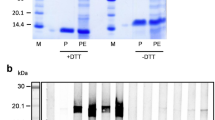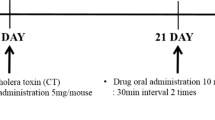Abstract
Anti-allergic effects of the hot water extract of Rosae multiflorae fructus (Rosae extract), which has long been used in oriental medicine for treatment of various diseases, were explored with a chicken ovalbumin (cOVA)-induced mouse model of food allergy. Compared to the sham mice to show severe allergic symptoms (i.e., anaphylaxis, diarrhea and decrease in the body temperature) following oral cOVA challenge, the Rosae extract-treated mice showed a marked improvement in those symptoms. Histology data demonstrated that Rosae extract treatment resulted in a amelioration in the intestinal inflammatory lesion and a reduction in the numbers of mast cells and eosinophils in the small intestine. Studies using DO11.10 TCR transgenic T cells indicated that Rosae extract had an activity to subdue the antigen-specific T cell activation/proliferation in vivo and thereby to lower the level of Th2 cytokine production by T cells during the antigen-specific immune response. Moreover, passive systemic anaphylaxis study showed that the extract also had an activity to inhibit the mast cells function in vivo, i.e., release of granules triggered by specific IgE-antigen interaction. Altogether, the results from this study not only imply a potential clinical application of Rosae extract in prevention and treatment of food allergy but also clearly elucidate the immunoregulatory mechanisms of Rosae extract underlying its anti-allergic effect.







Similar content being viewed by others
References
Sicherer SH, Sampson HA (2009) Food allergy: recent advances in pathophysiology and treatment. Ann Rev Med 60:261–277
Flokstra-de Blok BM, Dubois AE, Vlieg-Boerstra BJ, Oude Elberink JN, Raat H, DunnGalvin A, Hourihane JO, Duiverman EJ (2010) Health-related quality of life of food allergic patients: comparison with the general population and other diseases. Allergy 65:238–244
Gupta RS, Springston EE, Warrier MR, Smith B, Kumar R, Pongracic J, Holl JL (2011) The prevalence, severity, and distribution of childhood food allergy in the United States. Pediatrics 128:e9–17
Prescott SL, Pawankar R, Allen K, Campbell DE, Sinn JKH, Fiocchi A, Ebisawa M, Sampson HA, Beyer K, Lee BW (2013) A global survey of changing patterns of food allergy burden in children. World Allergy Organ J 6:21
Devereux G (2006) The increase in the prevalence of asthma and allergy: food for thought. Nat Rev Immunol 6:869–874
Berin MC, Sampson HA (2013) Mucosal immunology of food allergy. Curr Biol CB 23:R389–R400
Bischoff SC, Mayer JH, Manns MP (2000) Allergy and the gut. Int Arch Allergy Immunol 121:270–283
Cianferoni A, Spergel JM (2009) Food allergy: review, classification and diagnosis. Allergol Int Off J Jpn Soc Allergol 58:457–466
Bischoff SC (2007) Role of mast cells in allergic and non-allergic immune responses: comparison of human and murine data. Nat Rev Immunol 7:93–104
Galli SJ (2000) Mast cells and basophils. Curr Opin Hematol 7:32–39
Liang HE, Reinhardt RL, Bando JK, Sullivan BM, Ho IC, Locksley RM (2012) Divergent expression patterns of IL-4 and IL-13 define unique functions in allergic immunity. Nat Immunol 13:58–66
Wynn TA (2015) Type 2 cytokines: mechanisms and therapeutic strategies. Nat Rev Immunol 15:271–282
Cheng A (2011) Emergency treatment of anaphylaxis in infants and children. Paediatr Child Health 16:35–40
Syed A, Kohli A, Nadeau KC (2013) Food allergy diagnosis and therapy: where are we now? Immunotherapy 5:931–944
Berin MC, Mayer L (2013) Can we produce true tolerance in patients with food allergy? J Allergy Clin Immunol 131:14–22
Buchanan AD, Green TD, Jones SM, Scurlock AM, Christie L, Althage KA, Steele PH, Pons L, Helm RM, Lee LA, Burks AW (2007) Egg oral immunotherapy in nonanaphylactic children with egg allergy. J Allergy Clin Immunol 119:199–205
Dan B (1993) Gamble A: Chinese Herbal Medicine. In Materia Medica Revised ed Seattle: Eastland Press
Burns JJ, Zhao L, Taylor EW, Spelman K (2010) The influence of traditional herbal formulas on cytokine activity. Toxicology 278:140–159
Chung MY, Shin HS, Choi DW, Shon DH (2016) Citrus tachibana leaf extract mitigates symptoms of food allergy by inhibiting Th2-Associated responses. J Food Sci 81:H1537–H1545
Song Y, Qu C, Srivastava K, Yang N, Busse P, Zhao W, Li XM (2010) Food allergy herbal formula 2 protection against peanut anaphylactic reaction is via inhibition of mast cells and basophils. J Allergy Clin Immunol 126(1208–1217):e1203
Joon H (2012) Donguibogam; The Principles and Practice of Eastern Medicine
Li X (2002) Chinese materia medica: combinations and applications, 1st edn. Elsevier, Amsterdam
Jo Y-Y (2011) Agricultural and marine products that are allowed to be used other than food. http://www.mfdsgokr/seoul/indexdo?mid=58&pageNo=17&seq=12315&cmd=v
Cheng BC, Ma XQ, Kwan HY, Tse KW, Cao HH, Su T, Shu X, Wu ZZ, Yu ZL (2014) A herbal formula consisting of Rosae Multiflorae Fructus and Lonicerae Japonicae Flos inhibits inflammatory mediators in LPS-stimulated RAW 264.7 macrophages. J Ethnopharmacol 153:922–927
Cheng BC, Yu H, Guo H, Su T, Fu XQ, Li T, Cao HH, Tse AK, Wu ZZ, Kwan HY, Yu ZL (2016) A herbal formula comprising Rosae Multiflorae Fructus and Lonicerae Japonicae Flos, attenuates collagen-induced arthritis and inhibits TLR4 signalling in rats. Sci Rep 6:20042
Plaza M, Turner C (2015) Pressurized hot water extraction of bioactives. TrAC Trends Anal Chem 71:39–54
Brandt EB, Strait RT, Hershko D, Wang Q, Muntel EE, Scribner TA, Zimmermann N, Finkelman FD, Rothenberg ME (2003) Mast cells are required for experimental oral allergen-induced diarrhea. J Clin Investig 112:1666–1677
Meyerholz DK, Griffin MA, Castilow EM, Varga SM (2009) Comparison of histochemical methods for murine eosinophil detection in a RSV vaccine-enhanced inflammation model. Toxicol Pathol 37:249–255
Sridharan G, Shankar AA (2012) Toluidine blue: a review of its chemistry and clinical utility. J Oral Maxillofac Pathol 16:251–255
Ovary Z (1958) Passive cutaneous anaphylaxis in the mouse. J Immunol 81:355–357
Wex E, Thaler E, Blum S, Lamb D (2014) A novel model of IgE-mediated passive pulmonary anaphylaxis in rats. PLoS One 9:e116166
Kearney ER, Pape KA, Loh DY, Jenkins MK (1994) Visualization of peptide-specific T cell immunity and peripheral tolerance induction in vivo. Immunity 1:327–339
Shepherd DM, Dearstyne EA, Kerkvliet NI (2000) The effects of TCDD on the activation of ovalbumin (OVA)-specific DO11.10 transgenic CD4(+) T cells in adoptively transferred mice. Toxicol Sci Off J Soc Toxicol 56:340–350
Venetianer A, Aranyi P, Bosze ZS, Fachet J (1978) Sensitivity to glucocorticoids of lymph node cells stimulated in vivo by oxazolone. Scand J Immunol 8:355–362
McKay LI, Cidlowski JA (2003) Physiologic and Pharmacologic Effects of Corticosteroids. 6th edn
Burton OT, Darling AR, Zhou JS, Noval-Rivas M, Jones TG, Gurish MF, Chatila TA, Oettgen HC (2013) Direct effects of IL-4 on mast cells drive their intestinal expansion and increase susceptibility to anaphylaxis in a murine model of food allergy. Mucosal Immunol 6:740–750
Stone KD, Prussin C, Metcalfe DD (2010) IgE, mast cells, basophils, and eosinophils. J Allergy Clin Immunol 125:S73–S80
Martin LB, Kita H, Leiferman KM, Gleich GJ (1996) Eosinophils in allergy: role in disease, degranulation, and cytokines. Int Arch Allergy Immunol 109:207–215
Oka T, Rios EJ, Tsai M, Kalesnikoff J, Galli SJ (2013) Rapid desensitization induces internalization of antigen-specific IgE on mouse mast cells. J Allergy Clin Immunol 132(922–932):e16
Huang K (1999) The pharmacology of Chinese herbs, 2nd edn. CRC Press, Boca Raton, pp 118–120
Cheng BCY, Yu H, Su T, Fu XQ, Guo H, Li T, Cao HH, Tse AKW, Kwan HY, Yu ZL (2015) A herbal formula comprising Rosae Multiflorae Fructus and Lonicerae Japonicae Flos inhibits the production of inflammatory mediators and the IRAK-1/TAK1 and TBK1/IRF3 pathways in RAW 264.7 and THP-1 cells. J Ethnopharmacol 174:195–199
Song CH, Bui TT, Piao CH, Shin HS, Shon DH, Han EH, Kim HT, Chai OH (2016) Rosae multiflorae fructus hot water extract inhibits a murine allergic asthma via the suppression of Th2 cytokine production and histamine release from mast cells. J Med Food 19:853–859
Tixier E, Lalanne F, Just I, Galmiche JP, Neunlist M (2005) Human mucosa/submucosa interactions during intestinal inflammation: involvement of the enteric nervous system in interleukin-8 secretion. Cell Microbiol 7:1798–1810
Acknowledgments
We thank Linying Li and Sojin Choi in College of Pharmacy, Chungnam National University, for technical supports and discussions. We also thank Daewoon Choi and Hyejeong Shi in Korea Food Research Institute for preparation of Rosae extract. This work was supported by CNU Research Grant (2015-1858-01), a grant for Institute of Drug Research and Development in College of Pharmacy (CNU) (Natonal Research Foundation of Korea), grants from National Research Foundation of Korea (NRF-2015R1D1A1A02062348 and NRF-2014K1A4A3069114) and a grant from Korea Food Research Institute (E0121304-05). Nguyen Thi Minh Nguyet and Maria Lomunova are supported by BK21 Plus program by National Research Foundation of Korea.
Author information
Authors and Affiliations
Corresponding author
Rights and permissions
About this article
Cite this article
Nguyen, T.M.N., Lomunova, M., Shin, H.S. et al. Anti-allergic effects of Rosae multiflorae fructus via inhibition of T cell proliferation and the mast cell function. Appl Biol Chem 60, 391–402 (2017). https://doi.org/10.1007/s13765-017-0292-x
Received:
Accepted:
Published:
Issue Date:
DOI: https://doi.org/10.1007/s13765-017-0292-x




